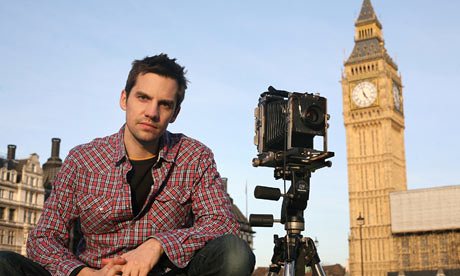
We had a lecture with Simons Roberts, who is a photographer, who is also interested in design.Simon became amazed when he noticed how many people had cameras, when he came across an article in the observer and he began to circle all of the cameras, within pictures of massive crowds of people. Simon wanted to explore how photography was involved with the media, famous people and the news.
In Simon’s early career, he decided to visit the local boxing ring in Sheffield, and captured some images of a boxer called Daniel, who was 13 and was destined to be big in boxing. As Simon began to follow Daniel, he began to challenge the pre conceptions, which come with being a boxer, as Daniel also attended tap class, which one might not expect. With the photos which Simon took, he won the Young Photographer of the Year Award for the Guardian and began to write for them.
Later, in 1999, Simon travelled to the Nevada Desert, where he captured some stunning images of people setting off Fireworks, which became a big part of his career, as he is still selling the images today’s for magazines and book covers etc. Simon has also worked for magazines such as Time.
In 2003, Roberts decided that he wanted to move on from what he was currently doing and so he travelled to Russia, where he began to challenge the negative connotations of the country. Simon wanted to explore how Russia had portrayed the landscaper of Russia through paintings, which were often of quite ordinary scenes. All of Simon’s pictures were shot with one camera and one lense and a tripod; he wanted all of his pictures to be the people within the surroundings, which tell us about the time and place. Simon also took portraits of the people, which I thought were very interesting and they made me think about what it would be like if I was to live in Russia.
Simon also photographed a lot of the rooms, which he stayed in which were admittedly quite peculiar. Simon got into the society very well, as he also got the opportunity to live with lots of different families, who offered to accommodate him. Below are some of the images, which Simons captured during his travels to Russia.
-

-
Identical twins, Elena and Vera Karnova, Magadan, Far East Russia, August 2004
-

-
Abandoned warship in the Kola Bay, Murmansk.
Northwestern Region, January 2005
-

-
Port officials, Vladivostok, Far East Russia, October 2004
-

-
Taxis cross the frozen Lena River, Yakutsk.
Far East Russia, November 2004
-

-
Young Boy and Girl, dance competition
-

Simon wanted to try and get the best pictures possible and he would use film, which meant that he had no clue how his photos, were going to turn out. Simons returned back to Britain and decided to try and capture the Americanisation of our country. Simon bought a motor home, which wasn’t just a great place to sleep, but he was able to get on top of the caravan and create elevated pictures, which enabled him to look down on what was going on; setting the people into the landscape.
In 2001, Simon was approached by the government to take some images of political candidates for an Artist to paint for the general election and in 2010, Simon was also given the chance to travel across the U.K. following the election, which meant that he had access to all three leaders and so he decided that he would only spend one day with each leader as he wanted to capture more wider subjects surrounding the election.

Gordon Brown, Labour, Rochdale, 28th April 2010 Kirkcaldy and Cowdenbeath constituency/ Photograph taken in Rochdale constituency

David Cameron, Conservative, Spelsbury, 6th May 2010 Witney constituency
As you can see, Simon captured the image from quite a distance, and raised the whole perspective of what was really happening in the election to open people’s eyes and maybe add a sense of humour.
Overall, I thought Simon Roberts work was really interesting and insightful.




































